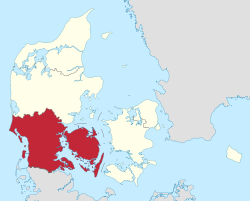
Back إقليم سيد دنمارك Arabic Dinamarca Meridional AST Region Syddanmark BAR Паўднёвая Данія Byelorussian Паўднёвая Данія (вобласьць) BE-X-OLD Южна Дания Bulgarian Danmark ar Su Breton Južna Danska BS Dinamarca Meridional Catalan Къилба Дани (регион) CE
Region of Southern Denmark
| |
|---|---|
 | |
| Coordinates: 55°20′N 9°40′E / 55.333°N 9.667°E | |
| Country | Denmark |
| Capital | Vejle |
| Largest city | Odense |
| Municipalities | |
| Government | |
| • Chairman | Stephanie Lose (V) |
| Area | |
| • Total | 12,191 km2 (4,707 sq mi) |
| Population (April 2021)[1] | |
| • Total | 1,224,100 |
| • Density | 100/km2 (260/sq mi) |
| GDP | |
| • Total | €61.686 billion (2021) |
| • Per capita | €50,500 (2021) |
| Time zone | UTC+1 (CET) |
| • Summer (DST) | UTC+2 (CEST) |
| ISO 3166 code | DK-83[3] |
| HDI (2019) | 0.930[4] very high · 3rd of 5 |
| Website | www |
The Region of Southern Denmark[5] (Danish: Region Syddanmark, pronounced [ʁekiˈoˀn ˈsyðˌtænmɑk]; German: Region Süddänemark, pronounced [ʁeˈɡi̯oːn zyːtˈdɛːnəˌmaʁk]; North Frisian: Regiuun Syddanmark) is an administrative region of Denmark established on Monday 1 January 2007 as part of the 2007 Danish Municipal Reform, which abolished the traditional counties ("amter") and set up five larger regions. At the same time, smaller municipalities were merged into larger units, cutting the number of municipalities from 271 before 1 January 2007 to 98. The reform diminished the power of the regional level dramatically in favor of the local level and the central government in Copenhagen. The Region of Southern Denmark has 22 municipalities. The reform was implemented in Denmark on 1 January 2007, although the merger of the Funish municipalities of Ærøskøbing and Marstal, being a part of the reform, was given the go-ahead to be implemented on Sunday 1 January 2006, one year before the main reform. It borders Schleswig-Holstein (Germany) to the south and Central Denmark Region to the north and is connected to Region Zealand via the Great Belt Fixed Link.
The regional capital is Vejle but Odense is the region's largest city and home to the main campus of the University of Southern Denmark with branch campuses in Esbjerg, Kolding and Sønderborg. The responsibilities of the regional administration include hospitals and regional public transport, which is divided between two operators, Sydtrafik on the mainland and Als, and Fynbus on Funen and adjacent islands. On the island municipalities of Ærø (since 2016)[6][7] and Fanø (since 2018),[8][9] the municipalities themselves are responsible for public transport.
- ^ FOLK1: Population 1 October database from Statistics Denmark
- ^ "EU regions by GDP, Eurostat". www.ec.europa.eu. Retrieved 18 September 2023.
- ^ "Denmark Country Codes". codesofcountry.com. Retrieved 11 April 2024.
- ^ "Sub-national HDI - Area Database - Global Data Lab". hdi.globaldatalab.org. Retrieved 2018-09-13.
- ^ "The Region of Southern Denmark". regionsyddanmark.dk. Retrieved 2022-01-22.
- ^ Dalgaard Nielsen, Kirstine (8 January 2016). "Nu kører Ærø selv bussen". Fyns Amts Avis (in Danish). Retrieved 2 September 2018.
- ^ Jørgensen, Sune (7 November 2017). "Langeland vil fyre Fynbus og gøre busserne gratis". TV 2/Fyn (in Danish). Retrieved 2 September 2018.
- ^ "Kollektiv Trafik - Bus 2018". fanoe.dk (in Danish). Fanø Municipality. Archived from the original on 28 August 2018. Retrieved 27 August 2018.
- ^ Bjerre-Christensen, Heidi (28 April 2017). "Skilsmisse mellem Fanø og Sydtrafik en realitet". JydskeVestkysten (in Danish). Retrieved 27 August 2018.
© MMXXIII Rich X Search. We shall prevail. All rights reserved. Rich X Search
